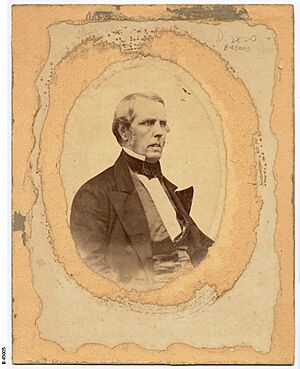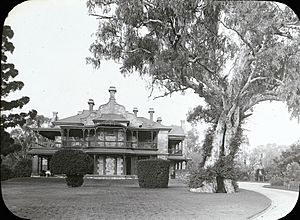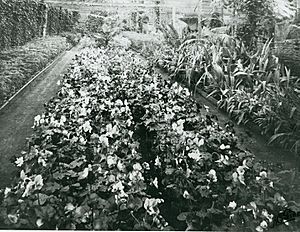Marryatville, South Australia facts for kids
Quick facts for kids MarryatvilleAdelaide, South Australia |
|||||||||||||||
|---|---|---|---|---|---|---|---|---|---|---|---|---|---|---|---|
| Postcode(s) | 5068 | ||||||||||||||
| LGA(s) | City of Norwood Payneham St Peters | ||||||||||||||
| State electorate(s) | South Australia | ||||||||||||||
|
|||||||||||||||
Marryatville is a small suburb located just a few kilometers east of Adelaide's city center. It's part of the City of Norwood Payneham St Peters council area. In Marryatville, you'll find homes, two big schools, a church, and several shops. Two creeks also flow through this area. The first European to settle here was George Brunskill in 1839. Later, in 1848, James Philcox bought some of the land and planned it out as a village.
Contents
Where is Marryatville?
Marryatville is surrounded by several main roads. Portrush Road is to its west, Kensington Road to the north, Tusmore Avenue to the east, and Alnwick Terrace/Romney Road to the south. It's next to Heathpool to the south and Kensington to the north. These suburbs are all part of the City of Norwood Payneham St Peters council. Marryatville also borders City of Burnside suburbs like Leabrook and Toorak Gardens.
Creeks Flowing Through Marryatville
Two creeks, called First Creek and Second Creek, run through Marryatville. Both of these creeks start in the Adelaide Hills. First Creek appears on the northern side of Alnwick Terrace, right inside the Marryatville High School grounds. It then flows through the school and under The Crescent. Second Creek passes under Hackett Terrace at its northern end. It flows through several properties before being put into a canal. In November 2005, big floods caused both creeks to overflow. This damaged Marryatville High School, Loreto College, and some nearby houses.
Marryatville's Early History
Before European Settlement
Before British people settled in South Australia, the land that is now Marryatville was home to the Kaurna people. They were one of the Aboriginal groups living in the area.
George Brunskill (1799–1866) arrived in Port Adelaide in February 1839. He had sailed from London in November 1838 on a ship called the Thomas Harrison. Brunskill first rented 66 acres of land from the South Australian Company. This land is now part of Marryatville. Around 1840, he planned to build an eight-room brick house on 6.5 acres of this land.
In 1839, Brunskill wrote that the countryside was "magnificent" after the rains. Trees, flowers, and vegetables were all growing well. He also mentioned that the local Kaurna people were "harmless" and didn't steal.
How Marryatville Got Its Name
On August 31, 1850, 46 acres of land were officially registered in Brunskill's name. The other 20 acres were bought by James Philcox in 1848. Philcox then planned out the "Village of Marryatville." The name came from Augusta Sophia Marryat. She was the wife of Sir Henry Young, who became the fifth Governor of South Australia in 1848. Augusta was also the niece of a famous novelist, Captain Frederick Marryat.
Brunskill's property stretched from Portrush Road to Ringmore Road (now Dudley Road). The village was located to the east of his property. One of the first buildings in the village was the Marryatville Hotel. It was a single-story building on the southern side. This hotel was near a building that still stands today. That building was built in 1908 and used to be a police station.
In 1851, George Hall started one of South Australia's first companies that made aerated waters (like fizzy drinks). This company was located on Ringmore (now Dudley) Road. The company later moved to Norwood and became very successful, producing soft drinks for 149 years.
Heathpool was one of three large properties that made up Marryatville, along with Eden Park and The Acacias.
The Kensington tram line was the first of several trams in Adelaide. It started with horse-drawn trams in 1878 and later became electric. There was a tram stop in Marryatville.
Marryatville in the 20th Century
In 1919, St Matthew's Church was renovated. A special plaque was added to honor those who died in World War I.
In 1923, Sun Street was made wider and renamed Hackett Terrace. This new name came from a local plant nursery.
In 1937, Alfred Traeger, who invented the pedal radio, moved his workshop to 11 Dudley Road. His company stayed there until he passed away in 1980. A memorial plaque marks the building, which is still there today.
Important Historical Properties
Eden Park
George Brunskill built his first home in 1839 on land that is now part of Loreto College. He later built another cottage and then a more elaborate house called Sandford. This house was on the site of what is now Eden Park. A huge Norfolk pine tree planted by the Brunskills still stands there. Brunskill also had a brick-making business and grew crops.
The Sandford property was sold several times before Thomas Roger Scarfe bought it in 1899. Thomas was part of the Harris Scarfe department store company. He found the old house too small and built the grand Victorian mansion known as Eden Park. It was designed by architect Alfred Wells. Thomas lived there until he died in 1915.
The state government bought the house and its gardens. It was used as a home for residents and then a school for nurses. In 1993, Marryatville High School acquired it. Since then, it has been used as a campus for students in their final year of high school.
The Acacias
The large house called The Acacias is on the corner of Portrush and Kensington Roads. It is now part of Loreto College. Dr J.M. Gunson built it in 1874-75. The land was originally given to important founding directors of the South Australian Company. Gunson bought the land in 1874 and built the house on a terrace above First Creek. He also created beautiful gardens.
Gunson sold the house to Sir Edwin Smith in 1878. Smith made the house much bigger, adding a verandah, a balcony from Glasgow, and a large ballroom. These additions were designed by architect Thomas English.
In December 1920, Loreto Convent bought the house and opened their school there in February 1921. The school has made more changes to the building over time.
Hackett's Nursery
The smallest street in Marryatville, now called Hackett Terrace, used to be Sun Street. Its name came from Hackett's Nursery, a family business started by brothers Elisha and Walter Hackett in the 1850s. Walter built a house in Marryatville around 1866. This land was bought from Brunskill. It was a long strip of land that people from Burnside used as a shortcut to St Matthew's Church.
Walter first planted fruit trees, but as the nursery grew, he removed them. The nursery grew and sold over 100,000 roses, as well as shrubs and trees. They also had glasshouses for plants like begonias and maiden-hair ferns. A shadehouse held palms and tree ferns. Native plants were also carefully grown. Walter's sons, John and then William, lived in the house after their father moved to Brighton. Walter continued to work at the nursery every day until he died in 1914.
In 1917, the nursery was sold to a company called E. & W. Hackett Limited. William continued to be a director for three years. The business also bought 6 acres of land in the Millswood Estate to expand the nursery. It continued to operate there until 1952.
Schools in Marryatville
Marryatville High School, on Kensington Road, is well-known for its music program. The school used to be called Norwood Boys Technical School. It was renamed and opened to both boys and girls in 1976. Eden Park, the big Victorian house built by the Scarfe family, is now used as the high school's Year 12 campus. The old timber stables have been turned into a music center.
In 2005, Marryatville's Performing Arts Centre, called The Forge, was opened. It's a place for Year 11 and 12 Drama productions. Other theater groups also use it. Some scenes from the movie Hey Hey It's Esther Blueburger (2008) were filmed at the school.
Loreto College is a private Catholic school for girls. It offers primary and secondary education, including boarding. It's located on the corner of Portrush Road and Kensington Road in Marryatville.
The local state primary school, Marryatville Primary School, is actually located in the nearby suburb of Kensington.
Shopping and Businesses
Marryatville has a business area often called Marryatville shops or the Marryatville/Kensington Park precinct. This area actually covers parts of four different suburbs, near the junction of Kensington Road and Tusmore Avenue in Leabrook.
The Marryatville Shopping Centre is located on the corner of Kensington Road and Tusmore Avenue. It was first built for a BI-LO supermarket in the early 1980s. This center was torn down and rebuilt in 2005–06. As of June 2019, it includes a Woolworths supermarket, a newsagency, a butchery, a liquor store, a Bakers Delight bakery, a yogurt shop, a pharmacy, a cafe, and an Asian food take-away shop.
Along Kensington Road in Marryatville, you can find a petrol station, a hairdresser, a pizza shop, and other businesses. Across the road in Kensington is the Marryatville Hotel. A little further east, there are more shops, the Kensington Park post office, and the historic Regal Theatre. This theater was built in 1925 in the art deco style.
On the south side of Kensington Road in Leabrook is a historic building from 1883. It was the original Marryatville Primary School. Today, it houses a large health center and a restaurant.




